AT THE LAST FULL MOON, I was invited to go on a special night hike at the Shaw Nature Reserve in Gray Summit, Missouri, which is located off of Interstate 44, west of Saint Louis. I took my camera to show some of the sights.
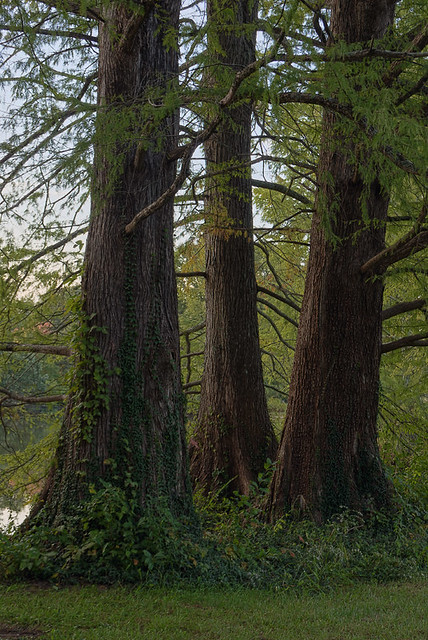
Cypress trees grow next to a pond.
Formerly called The Arboretum, the initial acreage of Shaw Nature Reserve was purchased by the Missouri Botanical Garden during the 1920s. Air pollution in Saint Louis, due to the burning of soft coal for heating, caused so much airborne ash as to threaten the plants at the garden, most especially its orchid collection. The plan was to relocate the botanical garden to the countryside: however, when the city switched to cleaner-burning anthracite coal, the move was abandoned.
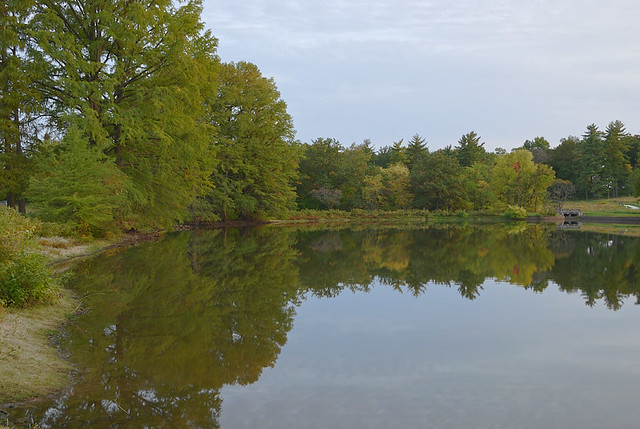
Part of the Reserve is actively managed to be a large, pleasant garden, as seen here, very much in the English tradition. This tradition makes an interesting distinction: a garden is designed to exclude animals (especially herbivores who might eat vegetables and flowers), while a park is designed to attract animals, especially deer and other game animals. This front area includes a high fence to exclude deer: a large wildflower garden, not seen in these photos, is nearby. Deer roam freely in the back area of the Reserve.

A stand of trees reflected in Pinetum Lake against the late afternoon sky.
The English landscaping tradition was brought to the United States by colonists. The full intellectual flowering of this tradition occurred during the Victorian period, when the Missouri Botanical Garden was established. During this time, garden and park design was influenced by long experience and by innumerable authorities from antiquity, the middle ages, and later periods, as well as taking into consideration knowledge gained from other cultures.
See the article Photos of Tower Grove Park, which includes links to primary sources used by garden and park designers of the late 19th century.
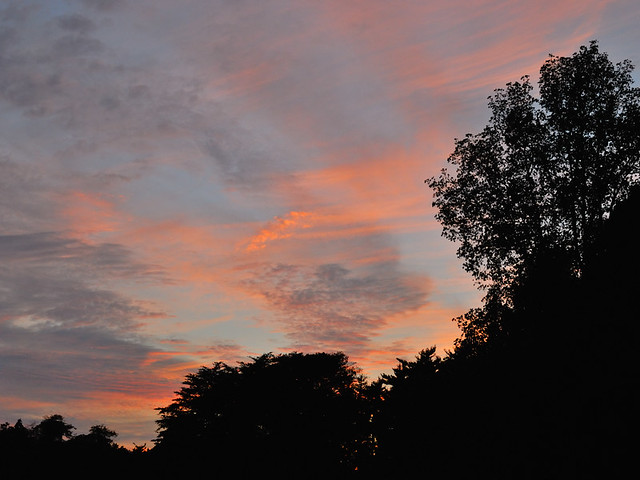
A glorious sunset, and the hike was soon to begin, led by an expert guide.
But the Victorian period was the twilight of the living landscape tradition. The idea that a landscape ought to be both useful and beautiful was in decline; in England, the Enclosure Acts and subsequent urbanization meant that the gardening tradition could only be practiced by a fortunate few instead of by the many. The advent of Modernism caused a divorce between agriculture and gardening. Farms became enormous in size and boring to look at due to monoculture, forests were managed to merely optimize the production of wood, with an emphasis on fire suppression, and odd modern theories of aesthetics led to gardens and parks that were often unpleasant and had little if any vegetation.
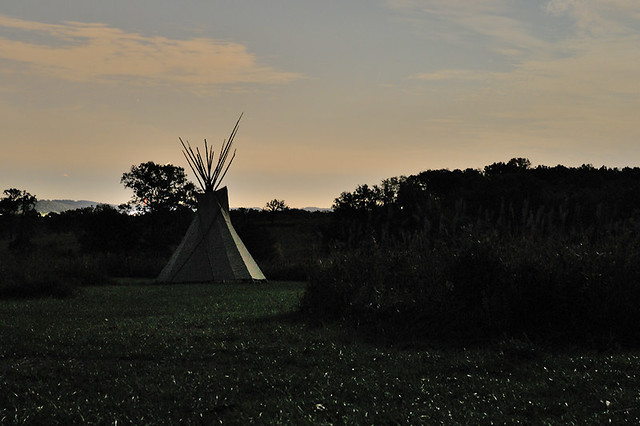
While the front part of the Reserve is managed to resemble a traditional English-style garden or park, the other parts are managed so as to restore the forest and prairies as they existed at the time of the initial European settlement of this area. Here is a large restored prairie area, and two primitive prairie-style homes are found here, including this teepee, and a nearby sod house — although our guide told us that these homes were not used in this part of the country, but rather two or three hundred miles to the west of here, in the Great Plains.
The earliest explorers of North America found that it resembled a large park in the English or European tradition. The explorers here found wide grasslands, appearing to be vast gardens, with vistas of wildflowers like an ocean of color, surrounded by forests of tall, ancient trees, with open ground below allowing for long views in all directions. Like a traditional European park, game was plentiful, and like a good garden, useful, edible, and beautiful plants were found everywhere.
But this was forgotten, and then dense, impenetrable forests soon grew throughout much of the territory of the United States. During this time of forestation, when Romanticism was the intellectual fad, there developed the misguided theory that the American Indians were noble savages, living lightly off the land, being “transparent in the landscape.” This ought to be contrasted with the earlier Enlightenment view of the Indians as being sub-human, only useful, if at all, as slaves. This false theory was revived after Darwinism, much to the detriment of those peoples subsequently, and the equally false noble savage theory regained prominence later, coinciding with the Environmentalist movement.
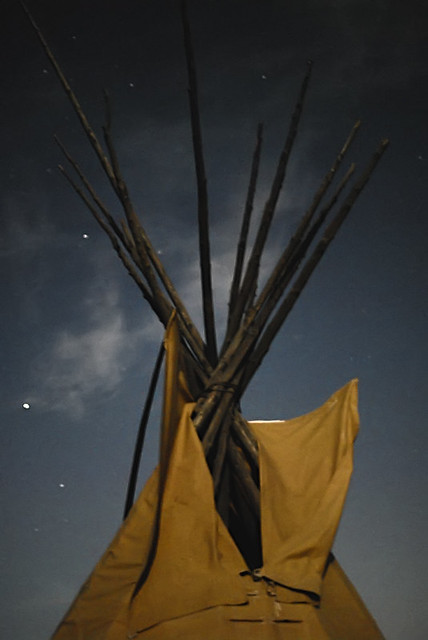
Dwelling illumined only by the full moon, with stars in the background sky. The image is a bit blurry because I didn't have a tripod with me for stability.
The word teepee (or tipi or tepee) comes from the Lakota word thipi, which derives from a plural form of the verb ‘to dewll.’ These were developed after European colonization, when the Indians obtained horses and found that they had to move more frequently to survive.
As it turns out, the Indians did not tred lightly on the land, but instead altered it greatly, often by using fire. There is no “natural landscape” of North America, especially since what came before was destroyed by the Ice Age; humanity came with the retreating glaciers and gardened the whole of the land. The natives used fire extensively to encourage game animals, promote growth of desirable vegetation, and for other purposes, producing a landscape that was simultaneously beautiful and fecund, far more than a land without man. This fact only became apparent by the 1970s; fire subsequently was recognized to be an essential ingredient of landscaping, and is used frequently at the Reserve.
We find the same thing in Europe where the tradition holds sway: fertile, beautiful landscapes that have an organic unity despite being heavily altered by man over the millennia, as can be seen in some remarkable photographs taken in Moravia and Tuscany here.
Indian culture, like all cultures, was problematic due to the effects of original sin. But the Indians were perhaps closer to orthodoxy than are modern men, the Indians retaining a memory of the order of the cosmos, natural law, and how things ought to be, all things which modernity rejects. The traditional gardening practices of the Indians show a largely orthodox understanding: man's dominion over nature, as found in Genesis, does not equate to either a libertarian or socialistic totalitarian dominance over nature, nor does it show a gnostic-like hatred of nature, neither a world divided between man and nature with a high wall of separation between them. Rather, man is recognized as being at the summit of nature while sharing a close kinship with it; this nature is a gift to man deserving of thanksgiving, and man owes obedience to that which is above. Not surprisingly, the Indians became exemplary Catholics, and Catholic priests accompanied their sorrowful flocks to the reservations. Sadly, since then, both the state and commerce have aggressively pursued their modernization.
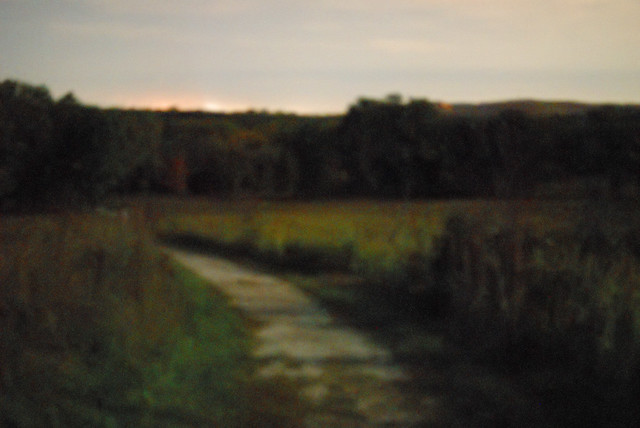
This not an impressionistic painting of the prairie, but rather a greatly underexposed photograph, with lots of Photoshop used to brighten it, reduce digital noise, and otherwise improve it. My techniques can be found here.
Since this was a long hike, and my tripod is quite heavy, I didn't carry it with me. As dusk ended, I attempted to take photos by hand, even though the camera's exposure meter said it was inadvisable. Now, I don't have one of those newer cameras which have great light-amplifying power, so I had to push the camera to the limits of its performance, and clean up the mess afterwards on the computer. I find that these photos resemble paintings in some ways. I find great inspiration in the art of painting: sometimes reality is unrealistic, and so the more-abstracted and freer art of painting can give a better impression than a photograph. Were I to have used a tripod, this scene would have been nearly indistinguishable from broad daylight; rather, this image maybe gives a better representation of the prairie road under the moonlight.
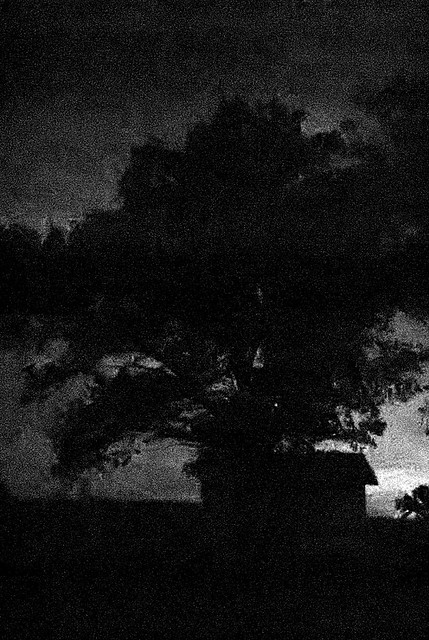
This is the sod-house, located on the prairie. This is just about at the limit of what you can do with a camera and still call it photography. During the time I was making this image, I was reading about the Japanese notan principle of design, which uses only a few levels of tones to produce a flat-looking image which emphasizes edges.
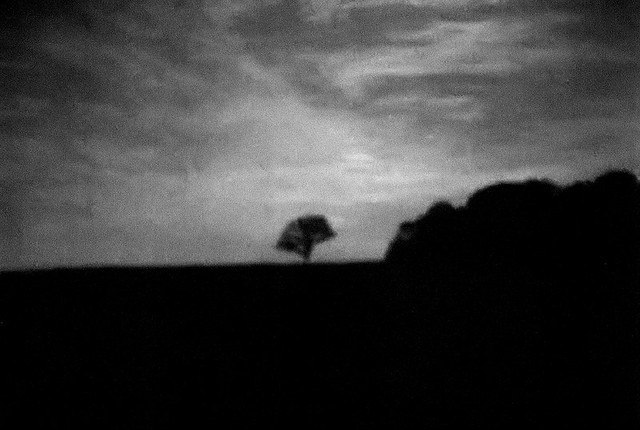
I found this lone tree interesting. Were it not for the other hikers disappearing off into the distance, leaving us behind, I would have stayed longer with this subject.
The emphasis of photography these days tends to be highly modernistic, desiring high technical image quality and realistic rendering. But it was not always so: an earlier photographic movement, called Pictorialism, instead emphasized the human impression of a scene as well as the expression of beauty, making photos more works of manual art, with a spiritual dimension, rather than mere products of technology. Perhaps these low-quality images can be seen in this light.


very informative and enjoyed viewing your photographs. pardon me for stating the obvious, but you are an artist. time spent on your site feeds the mind and soul.
ReplyDeleteGreat photos!
ReplyDeleteIt is amazing how establishment historians even ignore the fact that the Indians fought wars amongst themselves for natural resources, land and even just to kill the other tribe. The noble savage is perhaps now applied to the noble Arab Spring protester. Such ignorance and revision.
The greatest thing that can happen to modern society is a re-learning of original sin. It is astounding and depressing how many Christians even do not believe in Original Sin and think it evil to even mention or even believe in it.
The beginning of wisdom is the fear of God...